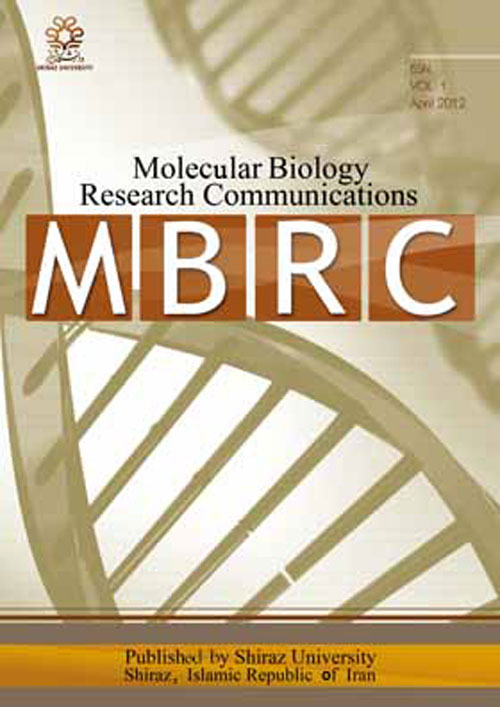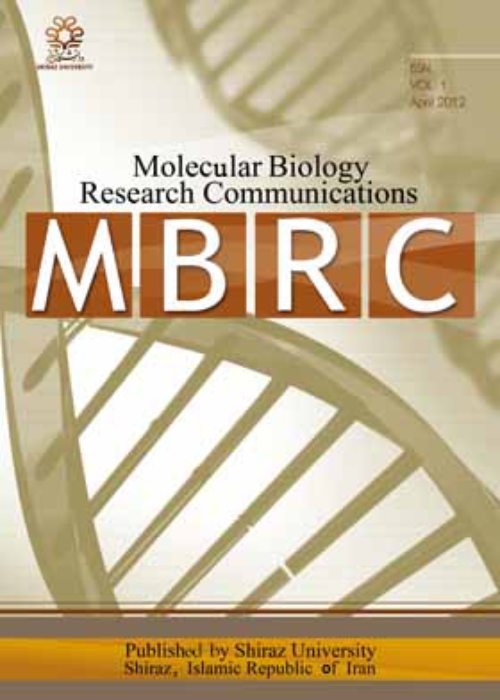فهرست مطالب

Molecular Biology Research Communications
Volume:8 Issue: 3, Sep 2019
- تاریخ انتشار: 1398/06/10
- تعداد عناوین: 6
-
-
Pages 99-102Atherosclerosis is one of the most important coronary artery disease (CAD) caused by lipid accumulation, hypertension, smoking, and many other factors such as environmental and genetic factors. It has been recorded that genetic variations in rs10757278 and rs1333049 are correlated with CAD. In the present study, 100 blood samples were collected (50 CAD patients and 50 appeared to be healthy controls), who referred to Ibn-Albytar general hospital/in Bagdad city for heart disease from February to March 2019. Genotyping for two SNPs rs10757278 and rs1333049, were done by Tetra ARMS method. For the rs10757278 polymorphism, the GG genotype verses to AA genotype was significantly associated with the risk of CAD (OR=5.16, 95% CI:1.02-26.0, P=0.047). For the rs10757278 polymorphism, there was no significant associatin between genotypes and the susceptibiulity to CAD. In the present study, the rs10757278 polymorphism showed an association with CAD.Keywords: rs10757278, rs1333049, Tetra ARMS, CAD, SNPs
-
Pages 103-111Although there are many health advantages assigned to different live bacteria such as probiotics, some health threatening effects have also been reported. For example, live bacteria can transfer antibiotic resistance genes to other commensal and opportunistic bacteria of gastrointestinal tract. Recently, it was shown that using killed bacteria have some advantages over live ones. In this research, heat, paraformaldehyde and ozone killing methods were used to kill the bacteria. Acetobacter cerevisiae, Lactobacillus acidophilus, Bifidobacterium lactis and traditional vinegar and fermented dairy product (Kumeh) derived bacteria were killed and their antibacterial activity against Streptococcus mutans and Escherichia coli was investigated. To identify the bacteria isolated from the traditional products, 16S rDNA gene was partially sequenced. The gene analysis showed vinegar and Kumeh derived bacteria were Acetobacter pasteurianus and Lactobacillus crustorum (LcK) strains respectively. The S. mutans growth inhibition was detected in the all concentrations of all killed samples. However, generally, E. coli showed more resistant to the killed bacteria than S. mutans and the antibacterial effect of heat-killed bacteria against E. coli was not observed in the all concentrations for some killed bacteria. Among the pathogenic bacteria, S. mutans was the most sensitive one to the killed bacteria with 70% of reduction in its viability. In conclusion, this research showed that different killed bacteria had different effects on other bacteria and the killing method showed an impact on these effects. Overall, paraformaldehyde-killed L.crustorum (LcK) showed the best antibacterial activity against S. mutans; about 70% decrease in bacterial viability.Keywords: Acetobacter, Lactobacillus, Bifidobacterium, killed bacteria
-
Pages 113-118Mutations in the BRCA1 gene are known to be a major cause of hereditary breast cancer. However, characterizing the point mutationsassociated with cancer in BRCA1 is challenging because the functional impact of most of them is still unknown. Nowadays, a variety of methods are employed to identify cancer-associated mutations in BRCA1. This study is aimed to assess the functional effects of two mutations, Asp1733Gly and Val1714Gly, using a combination of in silico tools and yeast functional transcription activator assay. Our computational analysis showed that theVal1714Gly mutation was deleterious, while the other one, Asp1733Gly, predicted as neutral. Also using yeast functional transcription activator assay, we found that the Asp1733Gly mutation displayed similar ability with positive controls. In contrast, the Val1714Gly mutation completely abrogated transcriptional activity in the yeast. These results suggested that Val1714Gly and Asp1733Gly can be classified as pathogenic and benign mutations for the BRCA1, respectively.Keywords: BRCA1, in silico tools, Functional assay, Yeast
-
Pages 119-128Bioinorganic medicinal chemistry remains a hot field for research aimed at developing novel anti-cancer treatments. Discovery of metal complexes as potent antitumor chemotherapeutics such as cisplatin led to a significant shift of focus toward organometallic/ bioinorganic compounds containing transition metals and their chelates as novel scaffolds for drug discovery. In that way, transition metal complexes coordinated to essential biological scaffolds represent a highly promising class of compounds for design of novel target-specific therapeutics. Here, we report novel data on p53 activating Isatin-based Cu(II) complex exhibiting cytotoxic properties towards HCT116 and MCF7 tumor cell lines, as confirmed by cell viability assay and flow cytometry analysis of apoptosis. Furthermore, putative p53-mediated mechanism of action of this compound is supported by quantitative analysis of TP53, MDM2 and PUMA genes expression, as well as luciferase-based p53 pathway activation assay. Multiplex immunoassay analysis of inflammatory markers revealed potential modulation of several cytokines and chemokines.Keywords: p53, Transcriptional activity, Isatin-Schiff base, Metal complex, Tumor cells
-
Pages 129-133Mutation in the dystrophin gene results Duchenne Muscular Dystrophy (DMD), an X-linked fatal neuromuscular disorder. Dystrophin deficiency can be compensated by upregulation of utrophin, an autosomal homologue of dystrophin. But the expression of utrophin in adults is restricted to myotendinous and neuromuscular junctions. Therefore utrophin upregulation throughout the muscle fiber can only be achieved if we understand regulatory mechanisms behind its expression. Utrophin-A 5′UTR mediated repression of translation was reported earlier. In this article, we present evidences of two transcript variants of utrophin-A that do not confer repression to the downstream reporter ORF in mouse myoblast C2C12 cells. These repression-free variants may be targeted for utrophin upregulation.Keywords: DMD, Utrophin, 5′RACE
-
Pages 135-140The objective of the study was to analyze the frequency of APOE4 allele in elderly patients with Alzheimer’s or vascular dementia or depression; compare these to age/sex matched controls; compare the results with established literature and highlight new findings.A single center, multiple disease, case-control study was performed with three case groups- probable AD patients (n=36), vascular dementia patients (n=29) and depression patients (n=20) and with a control group (n=32). APOE genotyping was performed in whole blood samples collected from patients and controls by restriction isotyping using the enzymes AflIII and HaeII. There was significant difference in frequency distribution of E4 allele between the AD (12/72; 16.7%) and control groups (3/64; 4.7%) (P=0.03). However, no significant difference was found in any of the other comparisons. The current study demonstrates absence of a significant association between APOE4 positivity and presence of late-onset depression in the north Indian elderly and reinforces the higher APOE4 prevalence in LOAD patients but not in VD patients. It is the first study of its kind from the northern part of India involving multiple disease groups and lays the framework for larger cohort studies.Keywords: Alzheimer’s disease, APOE, Depression, Vascular dementia


